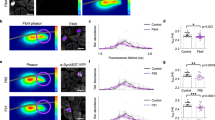Abstract
The premelanosomal protein (Pmel17) is a human functional amyloid that promotes pigmentation by serving as a scaffold for melanin polymerization. This occurs within the melanosome, where Pmel17 is first proteolyzed into smaller domain(s) that are responsible for fibril formation. Our work has shown that the Pmel17 repeat domain (RPT, residues 315–444) forms amyloid fibrils in vitro under acidic conditions similar to those found in melanosomes. Mechanistically, this is driven by the protonation of acidic residues, resulting in charge neutralization and subsequent aggregation. Interestingly, the deprotonation of acidic residues leads to rapid disaggregation, highlighting a reversible mechanism of fibril formation and dissolution thus far only observed for functional amyloid proteins. In this chapter, we describe how to monitor pH-dependent RPT aggregation and disaggregation using extrinsic thioflavin-T and intrinsic tryptophan fluorescence, respectively. These methods can also be adapted more broadly to investigate the reversibility of other amyloid systems, both functional and pathogenic.
Access this chapter
Tax calculation will be finalised at checkout
Purchases are for personal use only
Similar content being viewed by others
References
Chiti F, Dobson CM (2017) Protein misfolding, amyloid formation, and human disease: a summary of progress over the last decade. Annu Rev Biochem 86:27–68. https://doi.org/10.1146/annurev-biochem-061516-045115
Fowler DM, Koulov AV, Balch WE et al (2007) Functional amyloid – from bacteria to humans. Trends Biochem Sci 32(5):217–224. https://doi.org/10.1016/j.tibs.2007.03.003
McGlinchey RP, Lee JC (2017) Reversing the amyloid trend: mechanism of fibril assembly and dissolution of the repeat domain from a human functional amyloid. Isr J Chem 57(7–8):613–621. https://doi.org/10.1002/ijch.201600080
Cohen SI, Vendruscolo M, Dobson CM et al (2012) From macroscopic measurements to microscopic mechanisms of protein aggregation. J Mol Biol 421(2–3):160–171. https://doi.org/10.1016/j.jmb.2012.02.031
Khurana R, Coleman C, Ionescu-Zanetti C et al (2005) Mechanism of thioflavin T binding to amyloid fibrils. J Struct Biol 151(3):229–238. https://doi.org/10.1016/j.jsb.2005.06.006
Watson MD, Lee JC (2019) N-terminal acetylation affects α-synuclein fibril polymorphism. Biochemistry 58(35):3630–3633. https://doi.org/10.1021/acs.biochem.9b00629
McGlinchey RP, Shewmaker F, McPhie P et al (2009) The repeat domain of the melanosome fibril protein Pmel17 forms the amyloid core promoting melanin synthesis. Proc Natl Acad Sci U S A 106(33):13731–13736. https://doi.org/10.1073/pnas.0906509106
Raposo G, Tenza D, Murphy DM et al (2001) Distinct protein sorting and localization to premelanosomes, melanosomes, and lysosomes in pigmented melanocytic cells. J Cell Biol 152(4):809–824. https://doi.org/10.1083/jcb.152.4.809
Hu KN, McGlinchey RP, Wickner RB et al (2011) Segmental polymorphism in a functional amyloid. Biophys J 101(9):2242–2250. https://doi.org/10.1016/j.bpj.2011.09.051
McGlinchey RP, Jiang Z, Lee JC (2014) Molecular origin of pH-dependent fibril formation of a functional amyloid. Chembiochem 15(11):1569–1572. https://doi.org/10.1002/cbic.201402074
Pfefferkorn CM, McGlinchey RP, Lee JC (2010) Effects of pH on aggregation kinetics of the repeat domain of a functional amyloid, Pmel17. Proc Natl Acad Sci U S A 107(50):21447–21452. https://doi.org/10.1073/pnas.1006424107
Jiang Z, Lee JC (2014) Lysophospholipid-containing membranes modulate the fibril formation of the repeat domain of a human functional amyloid, Pmel17. J Mol Biol 426(24):4074–4086. https://doi.org/10.1016/j.jmb.2014.10.009
Pedersen JN, Jiang Z, Christiansen G et al (2019) Lysophospholipids induce fibrillation of the repeat domain of Pmel17 through intermediate core-shell structures. Biochim Biophys Acta Proteins Proteom 1867(5):519–528. https://doi.org/10.1016/j.bbapap.2018.11.007
McGlinchey RP, Gruschus JM, Nagy A et al (2011) Probing fibril dissolution of the repeat domain of a functional amyloid, Pmel17, on the microscopic and residue level. Biochemistry 50(49):10567–10569. https://doi.org/10.1021/bi201578h
McGlinchey RP, Lee JC (2018) Why study functional amyloids? Lessons from the repeat domain of Pmel17. J Mol Biol 430(20):3696–3706. https://doi.org/10.1016/j.jmb.2018.06.011
Dean DN, Lee JC (2019) pH-dependent fibril maturation of a Pmel17 repeat domain isoform revealed by tryptophan fluorescence. Biochim Biophys Acta Proteins Proteom 1867(10):961–969. https://doi.org/10.1016/j.bbapap.2019.01.012
McGlinchey RP, Shewmaker F, Hu KN et al (2011) Repeat domains of melanosome matrix protein Pmel17 orthologs form amyloid fibrils at the acidic melanosomal pH. J Biol Chem 286(10):8385–8393. https://doi.org/10.1074/jbc.M110.197152
Dean DN, Lee JC (2020) Modulating functional amyloid formation via alternative splicing of the premelanosomal protein PMEL17. J Biol Chem 295(21):7544–7553. https://doi.org/10.1074/jbc.RA120.013012
Author information
Authors and Affiliations
Corresponding author
Editor information
Editors and Affiliations
Rights and permissions
Copyright information
© 2023 Springer Science+Business Media, LLC, part of Springer Nature
About this protocol
Cite this protocol
Dean, D.N., Lee, J.C. (2023). Monitoring Kinetics of pH-Dependent Aggregation and Disaggregation of the Pmel17 Repeat Domain. In: Cieplak, A.S. (eds) Protein Aggregation. Methods in Molecular Biology, vol 2551. Humana, New York, NY. https://doi.org/10.1007/978-1-0716-2597-2_7
Download citation
DOI: https://doi.org/10.1007/978-1-0716-2597-2_7
Published:
Publisher Name: Humana, New York, NY
Print ISBN: 978-1-0716-2596-5
Online ISBN: 978-1-0716-2597-2
eBook Packages: Springer Protocols




